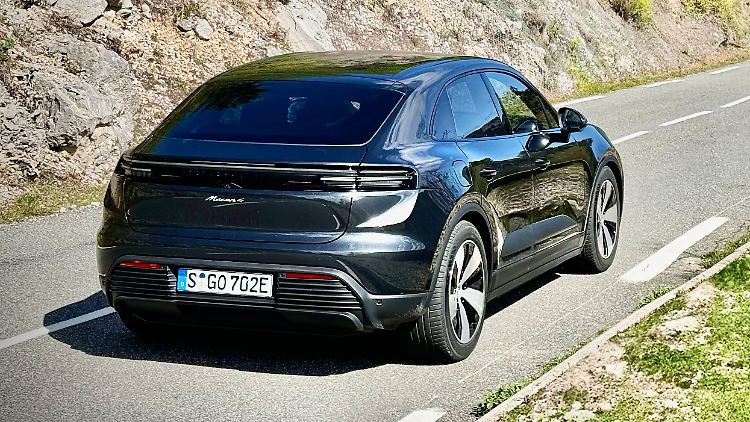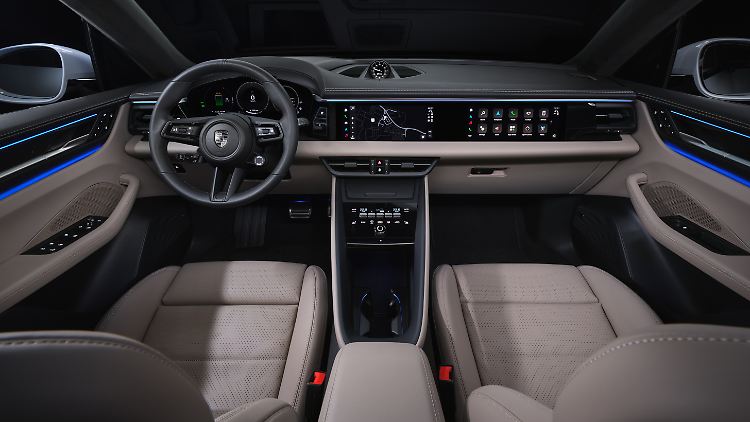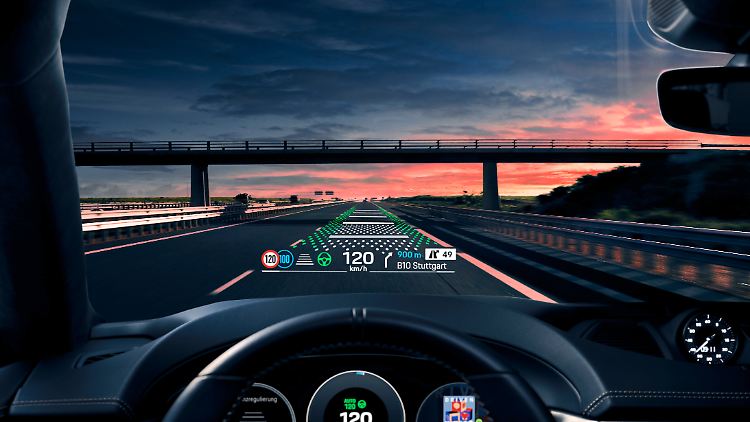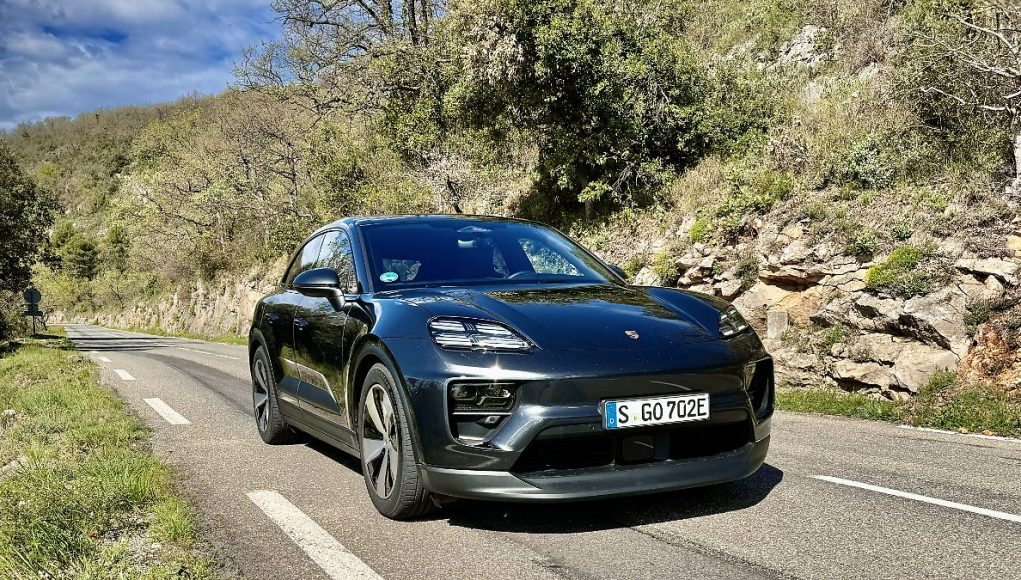With the second Macan generation, the model series says goodbye to the combustion engine drive. Whether this can work well remains to be seen in the future. ntv.de found out whether the electrically powered Porsche drives well.
For the first time, the electrically powered Macan is not just there to look at, but also to drive off. Skepticism? Might be appropriate. But not because the Macan drives poorly, but perhaps more because some Porsche customers simply want to continue driving combustion engines in the medium SUV category. Cold turkey or switching brands? That is the question now.


With its headlight design, the electrically powered Porsche Macan is strongly reminiscent of the Taycan, which is also electrically powered.
(Photo: Patrick Broich)
But enough speculation, just start now with the Macan, which, visually similar to the Taycan, underlines its drive through design. However, the fact that the start button is on the left side is not the only typical Porsche feature. That's good news. The Macan smells like a Porsche, the steering wheel feels like a Porsche.
Well, that was a bit of a time lapse, because I'm already rolling towards the road, with a Macan 4 on the forecourt as the first option here on the driving date. And since the first test drive starts in the dense city traffic of Antibes, not much happens for half an hour: the Macan silently makes its way through the traffic jam from traffic light to traffic light. But then the traffic jam clears and a long stretch of winding open road opens up in front of the twin-engine mid-range SUV. This is now the time when the Zuffenhausen-based company has to show that it is attractive enough even without the engine sound. The Macan can generate sound if desired, but of course you can't compare it with the natural noise of a combustion engine. It just seems synthetic. So turn it off in the menu and get rid of it. You can safely save yourself the 452 euros extra charge.
The electric Macan does not appear to be synthetic in any way


With 408 hp, the Porsche Macan 4 is by no means a weakling. However, the silent acceleration is not as dramatic as in a comparably powerful combustion engine model.
(Photo: Patrick Broich)
What doesn't feel synthetic at all in the Macan are the brakes and steering. But first there is the curvy route. And it's pretty free and deserted. So come on, full speed ahead with 408 hp in this case. This is not the continuous power, but at least the “overboost” power that is available for a short time. And the crazy thing is: the electrician gets off to a really powerful start from a standing start. But if the road is clear and you accelerate from higher speeds, you might think that a little extra effort is needed. Without noise, the drama is somehow missing. Here the old petrol Macan with significantly less power (245 or 265 hp) almost feels like it makes more sense. Okay, drama? All right, understood. Quickly went back, tortured through the city traffic, hit the vehicle hub and swapped the Macan 4 for a turbo. And then endure city traffic again into the countryside. And then fire, er, electricity release.
And the turbo is indeed a completely different caliber. If you press the right pedal towards the floor panel, the four-wheel drive will give you such a shock that it can make you dizzy, especially if there is some steering angle involved. Is that emotional? But something like that. Let's briefly compare the numbers: Instead of 5.2, the turbo storms the 100 km/h mark within 3.3 seconds. Oh yes, and by the way, the drive also produces 1130 Newton meters of torque (650 for the Macan 4). As a little treat, the Turbo also offers rear-axle steering (1,856 euros) plus air suspension (standard) plus an electronically controlled limited-slip differential for the rear axle (standard).
And it can also use the latter, because the engineers have made the SUV as active as possible. The steering fits precisely, reacts sensitively to commands and you find yourself always tending to bring a bit too much speed into the bend, which the athlete forgives despite its two and a half tons of curb weight (a low center of gravity can be so practical); The noble middle grader brakes no less precisely and masterfully conceals the fact that he only grinds away the pads when he presses the pedal really hard. With a recuperation output of 240 kilowatts, the Macan generates at least 40 percent of the maximum braking power. That's a lot of wood.
You have to get used to the loading issue


In the new Porsche Macan you can hardly escape the display. Of course, the front passenger also gets one as an option. Streaming offers are intended to shorten the loading time. However, the Stromer shouldn't use much of it.
(Photo: Porsche)
It looks like you can live quite well with the electric drive. Many customers are likely to remain skeptical because they still fear the charging adventure. ntv.de actually cannot check the charging performance here and now because the battery charge level rarely falls below 85 percent on this route. However, Porsche promises that the 95 kWh (net) battery with a peak charging capacity of 270 kW can be charged from 10 to 80 percent (800 volts) within 21 minutes. In other words, this means that the Porsche collects energy for 240 kilometers within ten minutes.
In Germany, however, the charging breaks could still be longer. So not on busy highways during the day. But if you cover longer distances in the evening hours on unlimited routes near the top speed of 220 (Macan 4) or 260 (Macan Turbo) km/h, the range is likely to shrink. Yes, then the combustion engine would probably have an advantage because you simply can't charge as quickly as you can refuel – but the loss of time should be manageable.
Porsche seems to take a relaxed view of this issue – and, in contrast to Audi, only uses performance-oriented permanent magnet synchronous machines, which results in around one kWh of additional consumption per 100 kilometers. The combined WLTP power consumption here is between 17.9 and 21.1 kWh per 100 kilometers. And in the optimal case, there should be a range of over 600 kilometers. That's probably a fair compromise.
The use of silicon carbide as a more efficient semiconductor material in the pulse inverter of the rear axle motor also proves that Porsche has not put any effort into the so-called PPE platform and is moving towards performance. In the case of the turbo, it works with 900 amps – which is, incidentally, the same value as the high-flyer Taycan Turbo GT.
But enough with the superlatives now. What is much more exciting is whether the Macan is even suitable as a travel professional. There is nothing to complain about with the seats, they are beyond reproach, air conditioning and massaging on request. How is the space available? That's okay, especially since the passengers in the second row in particular benefit from eight centimeters more wheelbase. However, the car has increased in length by a similar amount and is therefore unfortunately no longer as compact, which would be desirable for frequent use in urban areas.
On the other hand, the trunk volume has increased by 40 liters (to 540 liters) with the backrests up – good for traveling with a lot of luggage on board. Overall, however, the cargo space volume has shrunk; With the rear seats folded down, the luggage compartment now only swallows 1348 liters (instead of the previous 1500). But the purchase is unlikely to fail because of this.


The head-up display, which has become complex, can also distract from what is happening on the road. But this feature is cool.
(Photo: Porsche)
Finally, a look at the infotainment. Of course, there are plenty of displays – now also for the passenger. For example, you can enjoy streaming content on it if charging takes longer, perhaps at weak charging stations. And in the middle of the entire screen landscape is the analog clock from the so-called Sport Chrono package (815 euros). Maybe this will serve as a little treat to help advocates of the Old World make the transition.
By the way, Porsche calculates the basic prices ambitiously – nothing works for less than 84,100 euros. Turbo customers even have to shell out 114,600 euros. After all, company car drivers (and this is likely to affect a number of Macan customers) can be pleased that the halved gross list price is used as the basis for the flat-rate tax compensation for private journeys. This instrument should at least create enough incentive for a test drive. And maybe the new Macan will also convince old combustion engine fans. It would be conceivable given its performance and the authentic Porsche driving experience. The time will tell.
































